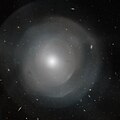NGC 474
| Galaxie NGC 474 | |
|---|---|
 | |
| NGC 474 (mittig) und NGC 470 (links), aufgenommen mithilfe des Víctor M. Blanco Telescope | |
| AladinLite | |
| Sternbild | Fische |
| Position Äquinoktium: J2000.0, Epoche: J2000.0 | |
| Rektaszension | 01h 20m 06,7s[1] |
| Deklination | +03° 24′ 55″[1] |
| Erscheinungsbild | |
| Morphologischer Typ | (R')SA(s)0^0^[1] |
| Helligkeit (visuell) | 11,3 mag[2] |
| Helligkeit (B-Band) | 12,3 mag[2] |
| Winkelausdehnung | 7,1′ × 6,3′[2] |
| Positionswinkel | 75°[2] |
| Flächenhelligkeit | 15,3 mag/arcmin²[2] |
| Physikalische Daten | |
| Zugehörigkeit | NGC 470-Gruppe NGC 488-Gruppe LGG 20[1][3] |
| Rotverschiebung | 0,007722 ± 0,000015[1] |
| Radialgeschwindigkeit | (2315 ± 5) km/s[1] |
| Hubbledistanz H0 = 73 km/(s • Mpc) | (107 ± 8) · 106 Lj (32,7 ± 2,3) Mpc [1] |
| Durchmesser | 220.000 Lj[4] |
| Geschichte | |
| Entdeckung | Wilhelm Herschel |
| Entdeckungsdatum | 13. Dezember 1784 |
| Katalogbezeichnungen | |
| NGC 474 • UGC 864 • PGC 4801 • CGCG 385-071 • MCG +00-04-085 • 2MASX J01200669+0324549 • Arp 227 • GC 269 • H III 251 • 2MASS J01200667+0324558 • LDCE 85 NED002 • KTG 5C | |
NGC 474 ist eine Post-Merger-Galaxie und eine Shell-Galaxie am Südrand des Sternbildes Fische auf der Ekliptik, an der Grenze zum Walfisch. Gemeinsam mit NGC 470 bildet sie ein loses Galaxienpaar. Wahrscheinlich haben Wechselwirkungen zwischen diesen beiden Galaxien die ungewöhnlich komplexe Struktur von NGC 474 verursacht.[5] Die Galaxie ist das zentrale Objekt der Galaxiengruppe Arp 227.
Halton Arp gliederte seinen Katalog ungewöhnlicher Galaxien nach rein morphologischen Kriterien in Gruppen. Diese Galaxie gehört zu der Klasse Galaxien mit konzentrischen Ringen.
Das Objekt wurde am 13. Dezember 1784 von dem deutsch-britischen Astronomen William Herschel entdeckt.[6]
Hochauglöste Aufnahme des zentralen Bereichs, Hubble-Weltraumteleskop
Literatur
- König, Michael & Binnewies, Stefan (2019): Bildatlas der Galaxien: Die Astrophysik hinter den Astrofotografien, Stuttgart: Kosmos, S. 217
- Jeff Kanipe und Dennis Webb: The Arp Atlas of Peculiar Galaxies – A Chronicle and Observer´s Guide, Richmond 2006, ISBN 978-0-943396-76-7
Weblinks
- Spektrum.de: Amateuraufnahmen [1][2][3]
- Galaxy NGC 474: Cosmic Blender, Galaxy NGC 474: Shells and Star Streams , APOD
- CDS Portal
- SIMBAD Astronomical Database
- Arp Atlas of Peculiar Galaxies
- Seligman Arp
Einzelnachweise
Auf dieser Seite verwendete Medien
Autor/Urheber:
DES/DOE/Fermilab/NCSA & CTIO/NOIRLab/NSF/AURA
Acknowledgments: Image processing: DES, Jen Miller (Gemini Observatory/NSF's NOIRLab), Travis Rector (University of Alaska Anchorage), Mahdi Zamani & Davide de Martin, Lizenz: CC BY 4.0Elliptical galaxies are generally characterized by their relatively smooth appearance when compared with spiral galaxies (one of which is to the left), which have more flocculent structures interwoven with dust lanes and spiral arms. NGC 474 is at a distance of about 100 million light-years in the constellation of Pisces. This image shows unusual structures around NGC 474 characterized as tidal tails and shell-like structures made up of hundreds of millions of stars. These features are due to recent mergers (within the last billion years) or close interactions with smaller infalling dwarf galaxies.
This image is an excerpt from the Dark Energy Survey, which has released a massive, public collection of astronomical data and calibrated images from six years of work. The Dark Energy Survey is a global collaboration that includes the Department of Energy's (DOE) Fermi National Accelerator Laboratory (Fermilab), the National Center for Supercomputing Applications (NCSA), and NSF’s NOIRLab. The image was taken with the Dark Energy Camera, fabricated by DOE, on the Víctor M. Blanco 4-meter Telescope.
The quality of the survey can be appreciated by diving into the zoomable version of this wider excerpt showing a background tapestry of thousands of distant galaxies.Hubble Peers Through Giant Elliptical’s Layers
Bright, white diffuse sphere with an extremely bright core. Diffuse shells of matter form layers around the core
This new NASA Hubble Space Telescope image captures the central region of the gigantic elliptical galaxy NGC 474. Located some 100 million light-years from Earth, NGC 474 spans about 250,000 light-years across – that’s 2.5 times larger than our own Milky Way galaxy! Along with its enormous size, NGC 474 has a series of complex layered shells that surround its spherical-shaped core. The cause of these shells is unknown, but astronomers theorize that they may be the aftereffects of the giant galaxy absorbing one or more smaller galaxies. In the same way a pebble creates ripples on a pond when dropped into the water, the absorbed galaxy creates waves that form the shells.
About 10% of elliptical galaxies have shell structures, but unlike the majority of elliptical galaxies, which are associated with galaxy clusters, shelled ellipticals usually lie in relatively empty space. It may be that they’ve cannibalized their neighbors.
The image was created using data from Hubble’s Advanced Camera for Surveys. Additional gap-filling data was provided by Hubble’s Wide Field and Planetary Camera 2 and Wide Field Camera 3. The color blue represents visible blue light while the color orange represents near infrared light.

